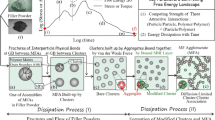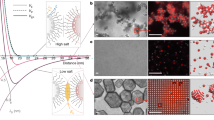Abstract
Carbon black in a polymer melt was used to model self-organized processes. A gradual growth of ionic concentration in the polymer melt induced a complex behavior, including a rapid increase in AC conductivity after a time delay. Colloid theory can provide an effective interpretation. The metamorphoses of the carbon black assembly include soft axial order generation, soft lateral order generation, axial condensation, and lateral condensation of carbon black particles, respectively. Similar processes are expected to be effective in generating complex carbonaceous organic structures in natural water.
Similar content being viewed by others
References
Yoshimura M. and Livage J., MRS Bulletin/September 2000, p. 12-16
Schueler R., Petermann J., Schulte K., Wentzel H.P., J. Appl. Polym. Sci., Vol. 63, 1741 (1997)
Bouda V., Carbon Black Network Formation in Conductive Plastics–MAPRET Series 10/1996. Praha: Process Engineering Publisher, 1996, ISBN 80-86059-12-X p. 1–65
Bouda V., Rajman J., Journal of Electrical Engineering 48 (1997) p. 5–55
Bouda V., ASME Congress 1997 Dallas. Proceedings: CAE and Intelligent Processing of Polymeric Materials, p. 281–298
Rajagopalan R., Hiemenz P.C.: Principles of Colloid and Surface Chemistry, 3rd ed., Dekker Marcel 1997
Visser J., Adv. Colloid Sci., 3 (1972) 331–363
Donnet J.B., Bansal R.C., Wang M.J. (Ed.), Carbon Black, 2nd ed., Marcel Dekker 1993
Bouda V., Chádek J., The ninth joint seminar Developments in Material Science in Research and Education, Gabcikovo 1999, Slovakia, Proceedings p. 40–41
Author information
Authors and Affiliations
Rights and permissions
About this article
Cite this article
Bouda, V., Chladek, J. Carbon Metamorphoses in a Medium with Varying Ionic Concentration. MRS Online Proceedings Library 661, KK5.17 (2000). https://doi.org/10.1557/PROC-661-KK5.17
Published:
DOI: https://doi.org/10.1557/PROC-661-KK5.17




